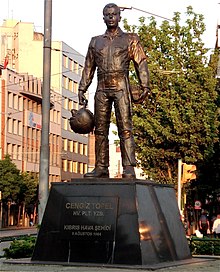터키계 키프로스 민족주의
Turkish Cypriot nationalism터키계 키프로스 민족주의는 북키프로스 터키공화국의 독립을 지지하는 민족 민족주의로, 그리스가 지배하는 키프로스 공화국과 키프로스를 통합하자는 생각에 반대하는 한편, 주로 TRNC가 터키로부터 독립하기를 바라고 있다.탁심의 목적, 즉 키프로스 섬을 터키와 그리스로 분할하는 것은 터키계 키프로스 민족주의자들 사이에 널리 퍼져 있다.그럼에도 불구하고 그들 중 상당수는 터키가 [1][2]키프로스를 합병하기를 바라고 있다.
역사
1911년 터키계 키프로스인들이 섬 전역에서 에노시스(키프로스와 그리스의 통일)에 반대하는 집회를 세 차례 열었다.이 집회는 20세기 터키계 키프로스 민족주의의 첫 번째 주요 사건이자 터키계 키프로스인들의 [3]엔조화에 대한 첫 번째 조직적인 행동이었다.1920년대는 엄격한 민족-종교적 구획의 측면에서 중요한 10년을 증명하기 위해 섬에 남아있던 터키계 키프로스인들은 점차 케말리스트 [4]혁명의 영향으로 터키 민족주의의 이데올로기를 받아들였다.
1950년대와 1960년대에 터키계 키프로스 민족주의는 주로 그리스와 그리스계 키프로스 민족주의와 섬 전체의 통합인 [5][6][7]에노시스(enosis)에 대한 열망에 대응하여 발전했다.처음에 터키계 키프로스인들은 영국 [8]통치의 지속을 선호했다.그러나 크레타와 그리스의 연합으로 피해야 [9][10]할 전례가 있던 크레타 투르크인들의 이탈이 일어난 것을 보고 그리스 키프로스인들이 에노시스(enosis)를 외치는 것에 놀라 EOKA의 [11]호전적인 활동에 대응하여 친분열적인 입장을 취하였다."탁심이냐 죽음이냐"라는 슬로건은 1950년대 후반과 1960년대 내내 터키계 키프로스와 터키의 시위에서 자주 사용되었다.취리히와 런던 회의 이후, 터키는 키프로스 국가의 존재를 인정하는 동시에, 섬의 분할을 선호하는 정책으로부터 거리를 두는 것처럼 보였지만, 터키와 터키 키프로스 지도자들의 목표는 섬 [12]북부에 독립적인 터키 국가를 건설하는 것이었다.
1964년 8월 6일, 키프로스 주방위군과 터키계 키프로스 무장단체들이 코코나 근처에서 충돌하기 시작했다.그리스계 키프로스가 코키나에서 철수하지 않고 터키계 키프로스의 보급품이 바닥날 때까지 포위군을 계속 투입할 것이 확실해진 1964년 8월 8일 터키는 개입했다.이 사건은 터키와 터키계 키프로스 민족주의의 중요한 전환점이 되었으며, 터키계 키프로스인들 사이에서 민족주의적 의견이 크게 증가하였다.이러한 증가는 대부분 [13][14]터키의 키프로스 합병에 찬성하는 것이었다.
1974년 7월 20일, 터키는 그리스 군사정부가 마카리오스 대통령에 대한 쿠데타를 후원한 후 섬을 그리스와 통합하기 위해 섬을 침공했다.코드네임 "아틸라 2"로 불리는 두 번째 터키 공격은 1974년 8월 14일에서 18일 사이에 일어났으며, 서쪽으로 코키나 지역까지 확장되었다.
「 」를 참조해 주세요.
레퍼런스
- ^ Xypolia, Ilia (2017). British Imperialism and Turkish Nationalism in Cyprus, 1923-1939 : divide, define and rule. London: Routledge.
- ^ Kyris, George (2016). The Europeanisation of Contested Statehood: The EU in Northern Cyprus. Routledge. pp. 30–1. ISBN 978-1317032748.
The rise of Turkish nationalism among the Turkish Cypriots can be largely seen as a response to the Greek Cypriot national "awakening" and campaign for union with Greece.
- ^ "KIBRIS". users.metu.edu.tr. Retrieved 2020-12-22.
- ^ Xypolia, Ilia. British imperialism and Turkish nationalism in Cyprus, 1923-1939 : divide, define and rule (Paperback ed.). Abingdon, Oxon. ISBN 0-367-34890-X. OCLC 1106094476.
- ^ Kızılyürek, Niyazi (2003). "The politics of identity in the Turkish Cypriot community : a response to the politics of denial?". Travaux de la Maison de l'Orient méditerranéen. 37 (1): 197–204.
The Turkish Cypriot nationalism developed mainly in reaction to the Greek Cypriot national desire for union with Greece.
- ^ Carter, Judy; Irani, Irani; Volkan, Vamık (2015). Regional and Ethnic Conflicts: Perspectives from the Front Lines. Routledge. p. 60. ISBN 978-1317344667.
- ^ Papadakis, Yiannis; Peristianis, Nicos; Welz, Gisela (July 18, 2006). Divided Cyprus: Modernity, History, and an Island in Conflict. Indiana University Press. p. 2. ISBN 9780253111913.
- ^ Isachenko, Daria (2012). The Making of Informal States: Statebuilding in Northern Cyprus and Transdniestria. Palgrave Macmillan. p. 37. ISBN 9780230392076.
- ^ Pericleous, Chrysostomos (2009). Cyprus Referendum: A Divided Island and the Challenge of the Annan Plan. I.B.Tauris. pp. 135–6. ISBN 9780857711939.
- ^ Mirbagheri, Farid (2009). Historical Dictionary of Cyprus. Scarecrow Press. p. xiv. ISBN 9780810862982.
Greek Cypriots engaged in a military campaign for enosis, union with Greece. Turkish Cypriots, in response, expressed their desire for taksim, partition of the island.
- ^ Behlul (Behlul) Ozkan (Ozkan) (26 June 2012). From the Abode of Islam to the Turkish Vatan: The Making of a National Homeland in Turkey. Yale University Press. p. 199. ISBN 978-0-300-18351-1.
In line with the nationalist rhetoric that "Cyprus is Turkish", Menderes predicated his declaration upon the geographic proximity between Cyprus and Anatolia, thereby defining "Cyprus as an extension of Anatolia". It was striking that Menderes rejected partitioning the island into two ethnic states, a position that would define Turkey's foreign policy regarding Cyprus after 1957
- ^ G. Bellingeri; T. Kappler (2005). Cipro oggi. Casa editrice il Ponte. p. 27. ISBN 978-88-89465-07-3.
The educational and political mobilisation between 1948-1958, aiming at raising Turkish national consciousness, resulted in the involving Turkey as motherland in the Cyprus Question. From then on, Turkey, would work hand in hand with the Turkish Cypriot leadership and the British government to oppose the Greek Cypriot demand for enosis and realise the partition of Cyprus, which meanwhile became the national policy.
- ^ Pierre Oberling, The Road to Bellapais: 북키프로스로의 터키계 키프로스 탈출, 사회과학논문, 1982, 페이지 120.
- ^ Dodd, Clement (21 April 2010). The History and Politics of the Cyprus Conflict. Springer. p. 69. ISBN 978-0-230-27528-7.



